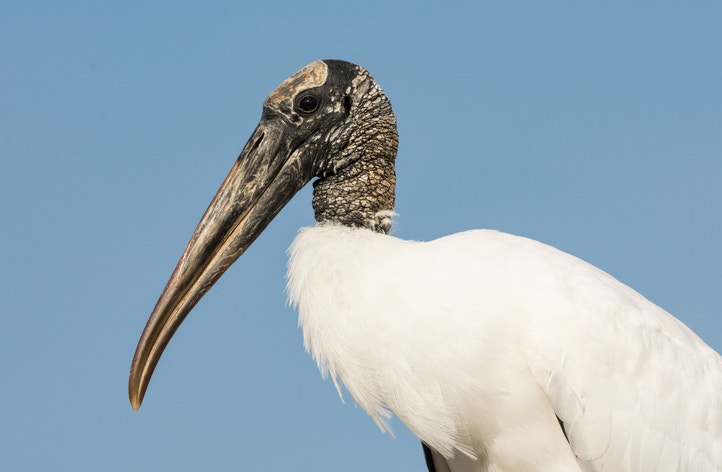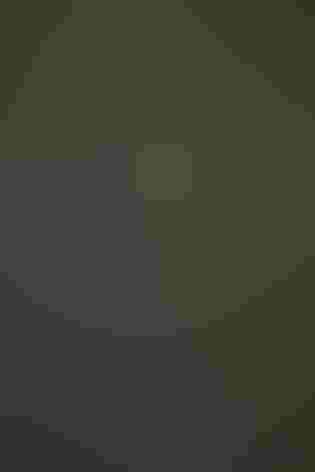Wood Stork
At a Glance
Our only native stork in North America, a very large, heavy-billed bird that wades in the shallows of southern swamps. Flies with slow wingbeats, and flocks often soar very high on warm days. Young Wood Storks have noisy begging calls, but adults are almost silent except for hissing and bill clappering. Florida populations have declined as water management there has become a more difficult problem.
All bird guide text and rangemaps adapted from by Kenn Kaufman漏 1996, used by permission of Houghton Mifflin Harcourt Publishing Company. All rights reserved.
Category
Long-legged Waders, Storks
IUCN Status
Least Concern
Habitat
Coasts and Shorelines, Freshwater Wetlands, Lakes, Ponds, and Rivers, Saltwater Wetlands
Region
California, Florida, Mid Atlantic, Plains, Rocky Mountains, Southeast, Southwest, Texas
Behavior
Direct Flight, Soaring
Population
450.000
Range & Identification
Migration & Range Maps
Not strictly migratory, but has a regular northward dispersal after nesting. Florida birds wander well north in eastern states; flocks of birds from eastern Mexico occur along Texas coast in summer; birds from western Mexico appear in summer at Salton Sea and elsewhere in southwest.
Description
40-44" (1-1.1 m). W. 5'6 (1.7 m). Huge and long-legged, with mostly white body, naked gray head, heavy bill. Juvenile has yellow bill and dusky head. In flight, black and white wing pattern suggests American White Pelican.
Size
About the size of a Heron
Color
Black, Gray, White
Wing Shape
Broad, Long, Rounded
Tail Shape
Rounded, Short, Square-tipped
Songs and Calls
Dull croak. Usually silent except around nest. Young make clattering noises with their bills.
Call Pattern
Flat
Call Type
Odd, Raucous
Habitat
Cypress swamps (nesting colonies); marshes, ponds, lagoons. Forages mainly in fresh water, including shallow marshes, flooded farm fields, ponds, ditches. Favors falling water levels (when fish and other prey likely to be more concentrated in remaining pools). Nests mainly in stands of tall cypress, also sometimes in mangroves, dead trees in flooded impoundments.
Sign up for 探花精选's newsletter to learn more about birds like the Wood Stork
Behavior
Eggs
3-4, sometimes 2-5. Whitish. Incubation is by both sexes, 28-32 days.
Young
Fed by both parents. During first 5 weeks or so, one parent usually guards young; unguarded nests may be attacked by unmated storks wandering through colony. Young may make short flights at about 8 weeks, but return to nest to be fed and to sleep until about 11 weeks old.
Feeding Behavior
Forages mainly by wading in shallow water with head down, bill in water and partly open; quickly snaps bill shut when it makes contact with prey. Can locate prey by touch or sight.
Diet
Mostly fish. Eats a wide variety of fish, especially minnows, killifish, mullet. Also crayfish, crabs, aquatic insects, snakes, baby alligators, small turtles, frogs, rodents, some seeds and other plant material.
Nesting
Breeds in colonies. Nests in winter and spring in Florida, where water levels (because of their impact on food supply) may dictate timing. In some years, may not attempt to nest at all. Nest site depends on colony location; may be 10-15' above water in mangroves, 80' or higher in cypress, usually well out on horizontal limb. Nest is flimsy platform of sticks, lined with twigs and leaves; male brings most materials, female may do most of building. Some sticks added to nest even after young hatch.
Conservation
Conservation Status
Population of southeastern United States was reportedly over 150,000 at one time, but by early 1990s probably not much over 10,000. Destruction of habitat and disruption of water flow through southern Florida were major causes of decline. Breeding population of far southern Florida has dropped sharply since 1970s, some of these birds apparently shifting north; has expanded breeding range north to South Carolina recently.
Climate Threats Facing the Wood Stork
Choose a temperature scenario below to see which threats will affect this species as warming increases. The same climate change-driven threats that put birds at risk will affect other wildlife and people, too.









